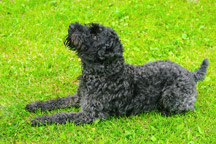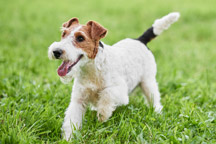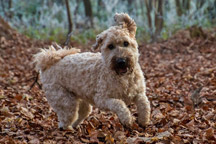Are Bedlington Terriers Hypoallergenic?
Yes! The Bedlington Terrier is a medium sized hypoallergenic dog that hardly drools or sheds.
Bedlington Terriers are a popular breed for people with allergies due to their hypoallergenic qualities. The most prominent hypoallergenic quality of this medium breed dog is its signature coat of hair. Bedlington Terriers have a very tight curl to their coat that has often been referred to as a crisp texture with distinct topknots. Because of their low-to-no shed coat, Bedlington Terriers are considered a hypoallergenic dog breed. These medium sized terriers are named after a mining town in Northumberland in North East England. They have also been referred as Rodbery/Rothbury Terriers or, affectionately, Rothbury’s Lambs. Rothbury’s Lamb is a very fitting name for this breed of terrier because of its unique coat that very much resembles that of a sheep’s thick wool. For a quick summary of the Bedlington Terrier breed features, skip to our Bedlington Terrier dog breed summary further down the page.
Are Bedlington Terriers Hypoallergenic Dogs? Contents
Bedlington Terrier Quick Facts
About the Breed
Bedlington Terrier Training and Exercise
Bedlington Terrier Grooming and Care
Bedlington Terrier Health Issues
Conclusion
Bedlington Terrier FAQ
Bedlington Terrier Breed Facts
Bedlington Terrier Quick Facts
| Hypoallergenic Dog: | Yes |
| Shedding: | Non-shedding |
| Drooling: | Low |
| Size: | Medium |
| Breed Group: | Terrier |
| Lifespan: | 12 – 14 years |
| Energy Level: | High |
| Trainability: | Medium Trainability |
| Family Dog: | Yes |
About the Breed
The Bedlington Terrier’s Characteristics and Appearance
(Skip this section) The Bedlington Terrier is a lively but gentle dog, built for speed, but looking like a lamb. Longer than it is tall, with an arched back, a slim, graceful build, this medium-sized terrier has a particularly distinctive look. With a fairly long, narrrow head and floppy ears, the top of the head is covered in crisp woolly hair, that tends to be lighter in color than the rest of its body. Their unique hypoallergenic coat is non-shedding – crisp and curly (but not wiry), it looks like sheep’s wool and can come in a variety of shades. Bedlington Terrier colors include blue, sandy, liver, blue and tan, sandy and tan, and liver and tan. Often, Bedlington Terrier puppies are born with a much darker coat than what will be present in adulthood. Weighing between 17-23lbs or 7.7-10.4 kgs Bedlington Terriers are considered to be medium size dogs. Females average about 16 inches, or 40cm, tall and males average 17 inches, or 43cm tall. They generally have a lifespan of 12 to 14 years. These dogs are considered to be very loving, spunky, smart, and good-tempered. They do very well with children, especially when raised around them from a young age. Bedlington Terriers are not intensely popular pets. Currently, they are ranked 151st by the American Kennel Club (AKC). However, of all the terrier breeds, the Bedlington Terrier has the oldest non-broken pedigree, going back to 1782. The breed was first known as the “gypsy dog” because gypsies and poachers used them to hunt. They have been known to hunt for small game such as rodents, rabbits, foxes, and even otters. They were used as racing dogs throughout the history of the breed. Their lifespan, averaging around 13.5 years, is somewhat longer than most dogs of a similar medium size. The longest-lived Bedlington Terrier on record was in 2004 from a UK Kennel Club survey. It was 18.4 years old.

Bedlington Terrier Temperament
These adaptable terriers have a very playful, spirited personality. Although very smart, they’re known to sometimes be a little stubborn. They can be quite protective of their loved ones. This bold dog is excellent with kids, but make sure you exercise him in fenced in areas because these dogs are very fast and they have a strong prey drive. Despite that, this medium-sized terrier is calmer inside than most terriers are so they are better in apartments.
Are you considering adopting a Bedlington Terrier?
Here are some things to watch out for :
- Bedlington Terriers are lively playmates for children and very affectionate with friends and family, and people and pets alike! They are calmer indoors than most terriers, but they were built to run at top speed and they absolutely require space to run off leash in a securely fenced in area.
- These dogs, while more laid back, definitely possess that “terrier temperament”. They have an intense prey drive and with bolt at breakneck speed. They may also be scrappy with strange dogs, so early socialization is key.
- In addition to their tendency to bolt after outdoor prey-type animals, these terriers may pose a threat to small, prey-like pets. Supervision around uncaged animals such as rabbits is recommended.
- While intelligent, these medium-sized hypoallergenic terriers can be stubborn and even pig-headed sometimes. Despite this, they are quite sensitive. Positive reinforcement training is an absolute must, and handlers should be patient, calm, and keep training sessions short and upbeat.
Bedlington Terrier Training and Exercise
Bedlington Terrier Training Tips – Encouraging Good Behavior In Your Bedlington Terrier
Bedlington Terriers are very active dogs. They need either a large yard to exercise in or to be taken on daily walks. They are energetic, rowdy, and may have a tendency to develop destructive tendencies if under-exercised. Bedlington Terriers are an acceptable breed for apartment living because they are a low barking dog. However, because of their high energy level, it’s particularly important apartment dwellers are given the opportunity to exercise every day, to prevent mischievous behaviors. Failure to do so can result in negative ‘boredom’ behaviors. This can also be true if Bedlington Terriers are left in solitude for long periods of time. These dogs have a very affectionate temperament, but they can only spend small amounts of time alone without becoming anxious. Bedlington Terriers are recommended for people with some dog training experience. Due to their intelligence, these dogs can be very easy to train. However, this dog breed has some typical terrier-like characteristics that may make it a challenging pet to handle. Due to their strong prey drive, it is also important to start socializing them with other dogs and children right away. Proper training is needed to ensure that barking is kept under control. Though Bedlington Terriers are only considered an occasional barker, it can become out of control if this breed is not managed by an owner it respects.
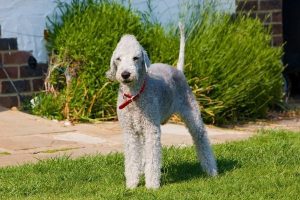
Bedlington Terrier Exercise Needs
Be warned! These dogs need a good amount of exercise! Bedlington Terriers won’t be satisfied without at least a half hour of good exercise a day. Luckily, these dogs are very playful. It helps to have a large fenced in backyard if you’re planning on owning one of these dogs. They’re a great option for families with slightly older kids with whom they can run and play. An under exercised Bedlington is likely to become destructive so be sure you have a plan on how to manage their needs before taking one into your family.
Bedlington Terrier Grooming and Care
Maintaining Your Bedlington Terrier’s Coat
(Skip this section) Due to the tight lamb-like texture of their coat, Bedlington Terriers need more work than most dog breeds. It is considered a high-maintenance breed, which must be brushed daily and groomed regularly. For this reason, most Bedlington Terriers are often kept in a close-cropped style, thus extending the time between grooming sessions. This both saves on grooming costs and reduces the amount of maintenance required to keep up with this terrier’s coat. Bedlington Terriers should have their coats clipped every 6 to 8 weeks. Bedlington Terriers’ non-shedding, distinctively cut coats must be brushed daily to prevent matting. It is also important to inspect your Terrier’s lamb-like coat for any debris if they are given the opportunity to exercise freely in a yard. Care should be taken to keep their woolly coat clean, which helps maintain healthy skin. If your Bedlington Terrier gets red, irritated skin on their belly after playing outside, try wiping them down with a baby wipe when they come in. Be sure to maintain a healthy weight for your Bedlington Terrier and give it plenty of opportunity to run and play. A lot of health problems that dogs suffer are due to obesity and being under-exercised.
Teeth, Ears, and Nails
Owners should carefully monitor the health of their Bedlington Terrier’s skin, teeth, and eyes. They’re known to have problems in this department and you will need to be conscientious about maintaining them. Routinely check the eyes for cloudiness or excessive tearing/blinking or scratching. Be sure to brush your dog’s teeth at least twice a week. It’s also a good idea to provide your Bedlington Terrier with teeth-cleaning treats they can chew on, but be sure to monitor how aggressively your dog chews, because swallowed pieces of rawhide and other firm materials can cause intestinal blockages
Health
Potential Bedlington Terrier Health Issues
(Skip this section) When purchased from a proper breeder who has provided documents proving the genetic health of their line, Bedlington Terriers are usually a very healthy breed. These dogs rarely need unexpected vet visits, and due to their short, silky coat, they do not retain ticks and fleas as readily as other breeds do and these pests are easy to see if they do occur. Like every dog however, there are some potential health concerns to be aware of. Hypothyroidism is a potential threat to Bedlington Terriers that is usually easy to detect and is successfully managed with medication. These dogs have also been known to develop teeth and eye problems. Despite the impressive healthiness of this breed, some Bedlington Terriers may suffer serious health concerns if purchased from a puppy mill: A factory-like establishment that breeds dogs in inhumane conditions without regard to the health of the parents or lineage, or the actual dogs themselves. puppy mills usually dispense the puppies they breed to stores that specialize in selling puppies. If you purchase a puppy from a store, rather than a dedicated breeder, you may find that your puppy suffers from a lot of genetic health complaints that well-bred dogs generally won’t have. In the case of the Bedlington Terrier, these may include the following: Mutant Alopecia (cryptorchidism or monorchidism), deafness, epilepsy, seizure disorder, juvenile cataracts, glaucoma, retinal atrophy, von Willebrand’s disease, and cancer.
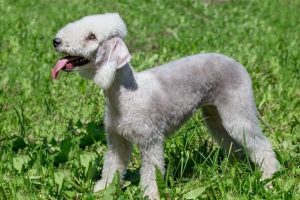
Common Health Issues for Bedlington Terriers
Retinal Dysplasia
Distichiasis
Progressive Retinal Atrophy
Copper Storage Disease
Although these dogs are healthier than most dog breeds, they do have some congenital health issues. Copper Storage Disease is very common in Bedlington Terriers, as are a variety of inherited eye diseases. It’s very important that breeders provide the proper tests for the parents. With proper genetic screening, you’re sure to end up with a healthy, energetic family dog!
Conclusion
(Skip this section) In the end, when looking for a dog with hypoallergenic qualities, a Bedlington Terrier is a good option for a medium size dog. Their thick lamb-like fur is considered to be non-shedding. They have a minimal amount of dander and drool very little. Despite their terrier energy, they are a bit more relaxed than some terriers, and are regarded as affectionate, playful, and easy to train. Adding a Bedlington Terrier to your home will provide you with an active, spunky, and non-allergenic family friend.
Bedlington Terrier FAQ
Are Bedlington Terriers good with children?
Yes! The Bedlington Terrier is an excellent family pet. They are energetic, happy, and playful! They’re larger than typical terriers, and their size makes them a bit more durable
Are Bedlington Terriers intelligent?
Yes! The Bedlington Terrier is highly intelligent. However, they can be stubborn when it comes to training.
Do Bedlington Terriers shed?
Bedlington Terriers barely sheds so they’re unusually good for people who are allergic to dogs.
Are Bedlington Terriers easy to train?
With the right approach, Bedlington Terriers can be fairly easy to train but they can be stubborn at times. This breed is also very sensitive, so owners need to use positive reinforcement. Owners with a bit of dog training experience will find it easier to employ the patience and positive reinforcement that this breed flourishes with!
Bedlington Terrier Breed Facts
| Breed | Bedlington Terrier (Medium-sized dog) |
| Other Names? | Rodbery/Rothbury Terriers, Rothbury’s Lamb |
| Height (inches and cm) | Female: 15–17 inches (38–42 cm), Male: 16–18 inches (41–44 cm) |
| Weight (pounds and kg) | Female: 17–23 lbs (7.7–10 kg), Male: 17–23 lbs (7.7–10 kg) |
| Lifespan | 14-16 years |
| Temperament | Lively, Bold, Playful |
| Colors | Liver, Blue, Blue & Tan, Sandy & Tan, Sandy, Liver & Tan |
| Coat – describe the coat | Tight, closely growing wooly curls with distinctive “top knots” |
| How much grooming? | Daily |
| How much shedding | Non-Shedding |
| Dander levels | Low |
| Saliva – Do they Drool or Lick much? | Low |
| Energy levels | High |
| How much exercise do they need? | 30 minutes daily |
| Health problems | Inherited eye diseases, copper storage disease |
| Good for apartment? | Excellent |
| Suitable for kids? | Excellent |
| How much do they bark? | A fair amount |
| Can they be left alone? | Not for long periods of time |
| Intelligent? | High |
| Trainable? | Medium – they can be stubborn |
| How popular as a pet? | Rare |











